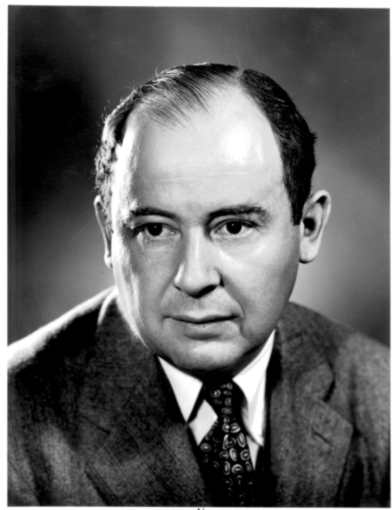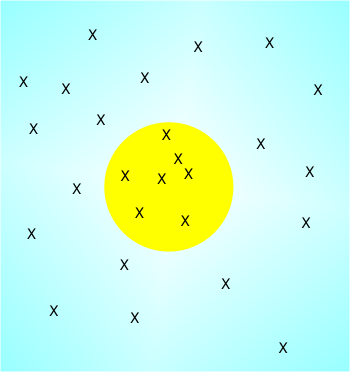| John Von Neumann The Great Polymath |
| Written by Historian | |||
Page 1 of 2 John Von Neumann was perhaps the first computer age polymath. He seemed to be capable of getting involved in just about any subject. Not content with inventing game theory, cellular automata and putting down the foundations of quantum mechanics, he invented the computer architecture we use most often today. If you know even a little about computer design you will have come across the term "Von Neumann architecture" probably in the context of what a big problem it is and how we need something better to make computers work faster. For this reason you may think that John Von Neumann got it wrong but in fact in all the years that have passed no-one has come up with a more generally acceptable way of organising a computer. If you scan the pages of computer history you will discover that Von Neumann turns up in so many places that it seem unbelievable that this is the work of one man.
Not only did Von Neumann come up with the only sensible organisation for a modern computer, he pioneered many of the great ideas of AI, game theory and many biological aspects of computing - yet he was a mathematician and produced all sorts of important mathematical work from Hilbert spaces and operator theory to continuous geometry. I have to admit that Von Neumann is a hero of mine. He was the sort of mathematician who managed to use his mathematics to understand the way things worked. He provided the foundations of modern quantum mechanics and even contributed to quantum computation.
John Von Neumann, 1903-1957
Neumann János Lajos was born in Budapest, Hungary in 1903. His family later changed his name to the German form Johann von Neumann. He was always interested in science and studied chemistry and then mathematics at the University of Berlin, and eventually at the University of Budapest. He was something of a child prodigy and knew calculus by age 8. He taught at a number of German universities before in 1930 accepting a position at Princeton University as a guest lecturer for one year - he stayed. He became a citizen of the USA and affectionately known as Johnny Von Neumann from then on. Poker and beyondDuring the 1920 and 30 he worked on what you can only call pure maths but with hindsight it is possible to see how it would lead on to computing - a subject that didn't exist at the time. He was interested in randomness and logic and he recast the mathematics of quantum mechanics into the nice neat form that we know today.
Even if Von Neumann had made no further contributions to computing he would be remembered for his study of poker. No really! In 1928 he started the subject of game theory with his major preoccupation the study of poker. Later to be rolled out in an even more complete form in a book with Oscar Morgenstern published in 1945. Game theory isn't about playing games of pure logic like chess or noughts and crosses but about games where human psychology comes into play. Games like poker where bluffing may not be entirely logical but it often works. It is about finding strategies that produce the best possible outcome taking into account the fact that your opponent can have knowledge of what you are doing and react accordingly. As the opening of the book Theory of Games and Economic Behavior by John von Neumann,Oskar Morgenstern explains: Our considerations will lead to the application of the mathematical theory of "games of strategy " developed by one of us in several successive stages in 1928 and 1940-1941. After the presentation of this theory, its application to economic problems in the sense indicated above will be undertaken. It will appear that it provides a new approach to a number of economic questions as yet unsettled. Von Neumann's theory of such games can be seen as making a start on the difficult job of analysing complex human behaviour with twin motive or understanding it better and, given a computer, automating it.
Game theory has been adopted by subjects as diverse as psychology, economics and AI. If he had done nothing else this would have been sufficient to establish his reputation. I like the image of Von Neumann staying up late into the night playing poker in the cause of further study! You can tell he was made of the right stuff! The Monte Carlo MethodHe then became interested in problems in applied mathematics - perhaps as a response to the threat of war. In 1943 defence work occupied most of his time as he joined the Manhattan Project at Los Alamos. This was the secret project to build the atomic bomb and while Von Neumann wasn't a physicist he knew how to work out the difficult sums needed to understand fission. His theoretical work on randomness suggested to him simulation methods that would give the answers everyone was looking for - but they needed some way of doing lots of simple calculations very rapidly. Today we would immediately think "computer" but that wasn't the case in 1945. What Von Neumann wanted to do was use simulations that incorporated randomness to see how various designs worked. This was the start of what we call the Monte Carlo Method and yes Von Neumann was an early contributor to this subject. The usual example of the Monte Carlo method is finding the area of a shape or in more mathematical terms - integration. You could do it using a deterministic splitting of the shape into small squares and then counting how many squares made up the shape. The accuracy of the result would depend on how small the squares were that you used. An alternative and generally faster methods is to generate pairs of random numbers that select a random point. The probability that the random point hits or misses the shape is proportional to its area. So all you have to do is generate lots of random numbers and count how often the shape is hit - this is sometimes called the shooting method. Again the result isn't perfect but the more random points you choose the more accurate it is.
Hitting the target – at random
The Monte Carlo method sounds easy but without a computer it involves lots of work throwing dice and working things out. It is a method that really only makes sense when you have a computer.
<ASIN:0691130612> <ASIN:082182676X> <ASIN:1107609267> <ASIN:0007214618> <ASIN:0691130612> <ASIN:038541580X> <ASIN:0071400206> <ASIN:0691028931> |
|||
| Last Updated ( Friday, 02 February 2018 ) |




